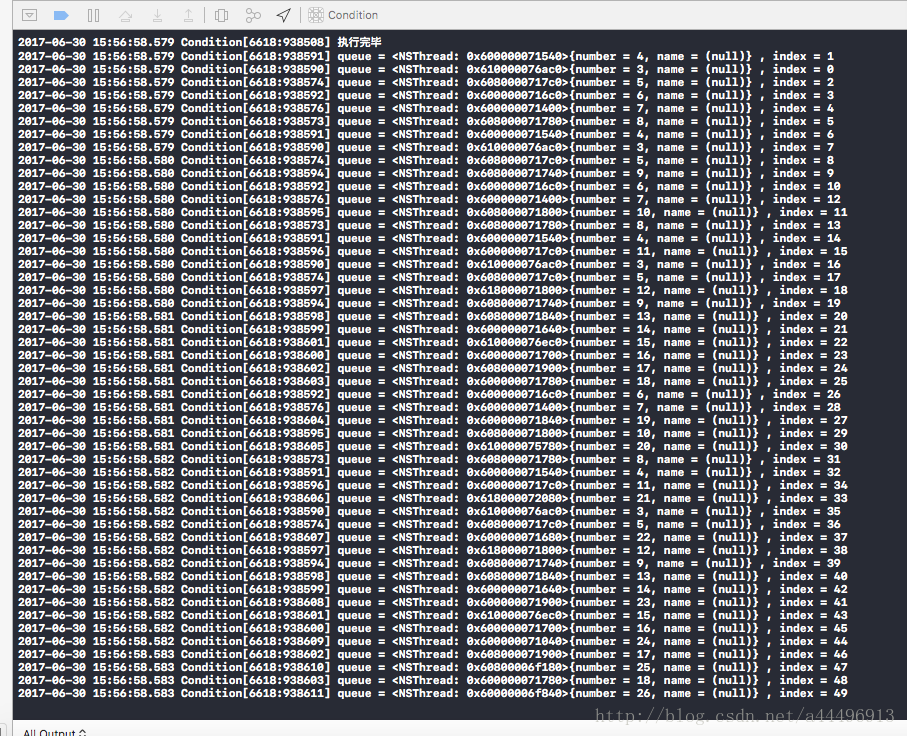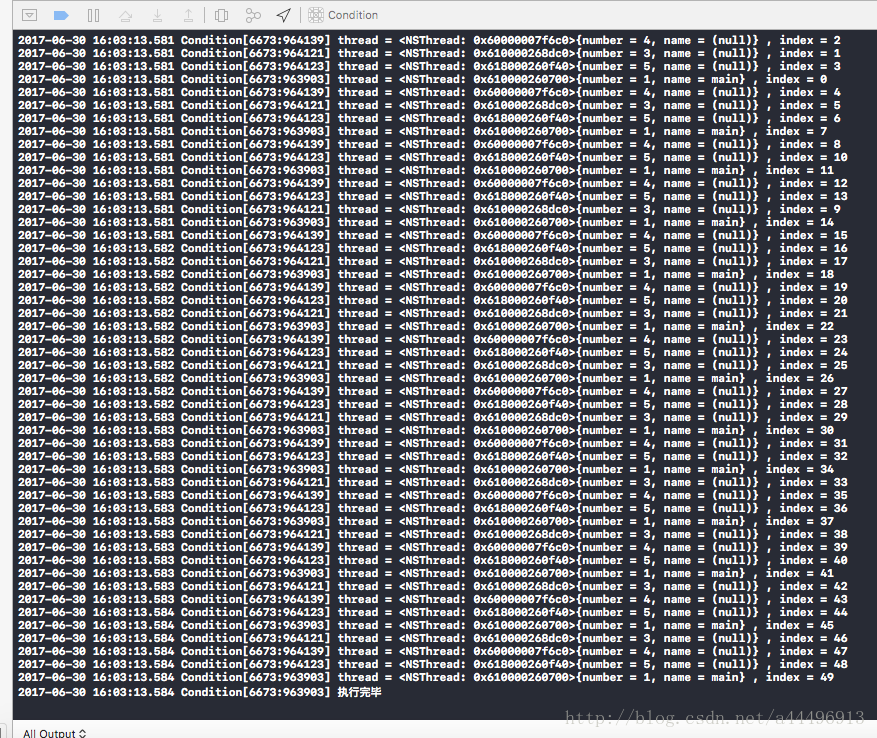dispatch_apply
dispatch_apply 可以像 for 循环一样多次执行其绑定的block,在所有block任务完成之后,再进行后续任务
/* iterations 执行次数
* queue 执行队列,并行或者串行,会影响到任务执行顺序
* block 具体任务
* size_t 执行下标,区分不同block,代表每个block执行顺序 */
void dispatch_apply(size_t iterations, dispatch_queue_t queue, DISPATCH_NOESCAPE void (^block)(size_t));
- 使用示例:
dispatch_queue_t queue = dispatch_get_global_queue(DISPATCH_QUEUE_PRIORITY_DEFAULT, 0);
dispatch_apply(5, queue, ^(NSUInteger index) {
NSLog(@"thread = %@ , index = %ld",[NSThread currentThread],index);
});

上面是并行队列,如果换成串行队列,会按顺序执行block
dispatch_queue_t queue = dispatch_queue_create("com.serial", DISPATCH_QUEUE_SERIAL);

- 对于批量处理相同的任务
dispatch_apply相较于 for 和 while 能更合理的使用资源
为了进行对比,先创建了一个数组作为处理对象,包含50个元素(ps:50个虽然少,但也能看到效果)。循环和
dispatch_apply都使用并行队列
//模拟操作对象
NSMutableArray *testArr = [NSMutableArray array];
for (int index = 0; index < 50; index ++) {
[testArr addObject:@(index)];
}
//执行队列
dispatch_queue_t queue = dispatch_get_global_queue(DISPATCH_QUEUE_PRIORITY_DEFAULT, 0);
- 使用for循环
for (int index = 0; index < testArr.count; index ++) {
dispatch_async(queue, ^{
NSLog(@"queue = %@ , index = %@",[NSThread currentThread],testArr[index]);
});
}
NSLog(@"执行完毕");

从结果中可以看出,执行过程创建了大量新线程
- 使用
dispatch_apply
dispatch_apply(testArr.count, queue, ^(NSUInteger index) {
NSLog(@"thread = %@ , index = %@",[NSThread currentThread],testArr[index]);
});
NSLog(@"执行完毕");

相较于 for 循环,
dispatch_apply在执行的过程中新创建的线程数要少得多,并且dispatch_apply会在其关联的block任务都执行完成后再进行后续任务的执行。所以,dispatch_apply在批量任务处理中还是很好用的。
dispatch_barrier
barrier 意思是栅栏,dispatch_barrier 称为栅栏函数,在存在栅栏函数,且使用DISPATCH_QUEUE_CONCURRENT创建的并行队列(非全局并行队列,原因后面说明)时,任务执行顺序会变为: 栅栏之前的任务 —-> 栅栏本身提交的block任务 —-> 栅栏之后的任务。
常用的有 dispatch_barrier_async 和 dispatch_barrier_sync ,两者区别在于异步和同步。下面以dispatch_barrier_async 举例:
- 使用举例
dispatch_queue_t cQueue = dispatch_queue_create("com.concurrent", DISPATCH_QUEUE_CONCURRENT);
dispatch_async(cQueue, ^{
[NSThread sleepForTimeInterval:5.0f];
NSLog(@"s1");
});
dispatch_async(cQueue, ^{
[NSThread sleepForTimeInterval:5.0f];
NSLog(@"s2");
});
dispatch_async(cQueue, ^{
[NSThread sleepForTimeInterval:5.0f];
NSLog(@"s3");
});
dispatch_async(cQueue, ^{
[NSThread sleepForTimeInterval:5.0f];
NSLog(@"s4");
});
//添加栅栏
dispatch_barrier_async(cQueue, ^{
for (int index = 0; index < 5; index ++) {
[NSThread sleepForTimeInterval:1.0f];
NSLog(@"thread = %@ , index = %d",[NSThread currentThread],index);
}
});
dispatch_async(cQueue, ^{
[NSThread sleepForTimeInterval:3.0f];
NSLog(@"y1");
});
dispatch_async(cQueue, ^{
[NSThread sleepForTimeInterval:3.0f];
NSLog(@"y2");
});
dispatch_async(cQueue, ^{
[NSThread sleepForTimeInterval:3.0f];
NSLog(@"y3");
});

- 注意点
使用栅栏函数时需要使用 DISPATCH_QUEUE_CONCURRENT 创建的并行队列,否则 dispatch_barrier_async 效果将与 dispatch_async 类似,失去栅栏的作用。
将上面的例子中队列换成 全局并行队列 再看看结果
dispatch_async(cQueue, ^{
[NSThread sleepForTimeInterval:5.0f];
NSLog(@"s1");
});
dispatch_async(cQueue, ^{
[NSThread sleepForTimeInterval:5.0f];
NSLog(@"s2");
});
dispatch_async(cQueue, ^{
[NSThread sleepForTimeInterval:5.0f];
NSLog(@"s3");
});
dispatch_async(cQueue, ^{
[NSThread sleepForTimeInterval:5.0f];
NSLog(@"s4");
});
//替换了执行队列后,栅栏效果消失
dispatch_barrier_async(dispatch_get_global_queue(DISPATCH_QUEUE_PRIORITY_DEFAULT, 0), ^{
for (int index = 0; index < 5; index ++) {
[NSThread sleepForTimeInterval:1.0f];
NSLog(@"thread = %@ , index = %d",[NSThread currentThread],index);
}
});
dispatch_async(cQueue, ^{
[NSThread sleepForTimeInterval:3.0f];
NSLog(@"y1");
});
dispatch_async(cQueue, ^{
[NSThread sleepForTimeInterval:3.0f];
NSLog(@"y2");
});
dispatch_async(cQueue, ^{
[NSThread sleepForTimeInterval:3.0f];
NSLog(@"y3");
});

从截图中可以看出,栅栏已经失效;需配合 DISPATCH_QUEUE_CONCURRENT 创建的队列才能生效。